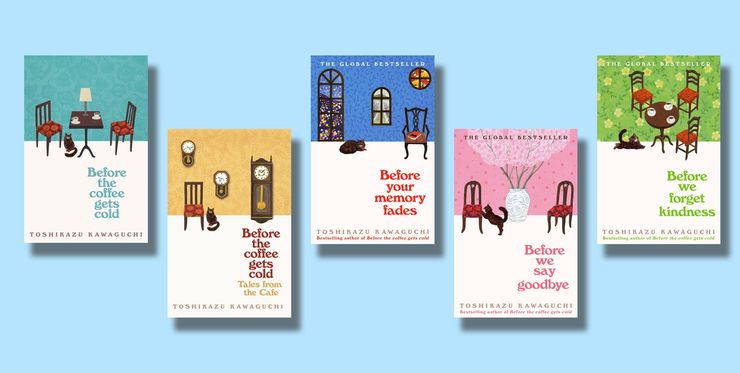Food for the soul: meals, memory and the Kamogawa Diner
Leah Cowan on Hisashi Kashiwai's Kamogawa Food Detectives and the power of food to reignite memories.

What’s the one dish you’d do anything to taste just one more time? This is the central question posed by the food-based Japanese sleuthing series The Kamogawa Food Detectives, in which a restaurant recreates meals from its customers' histories to help them remember the past and navigate the future. Here, Leah Cowan discusses the relationship between memory and food explored in the books.
There is a famous scene in Marcel Proust’s early-twentieth-century novel À la recherche du temps perdu (which translates to In Search of Lost Time). In it, the narrator eats a madeleine cake, and is transported back to a childhood memory of his aunt dipping a madeleine in a cup of tea and giving him a bite on Sunday mornings before mass. This oft-cited passage is perhaps the classic literary example of the way in which taste can reignite memories that otherwise lie dormant or unacknowledged. The close relationship between meals and recollections from our past has birthed a much-loved range of literature, including memoirs that explore food as a mechanism for connection and self-exploration, such as Tiny Moons by Nina Mingya Powles, Eat Up! by Ruby Tandoh, and Takeaway by Angela Hui. Hisashi Kashiwai’s fictional Kamogawa Food Detectives series also works upon this same idea: down a quiet backstreet in Kyoto, a family-run diner-come-detective agency is able to recreate any dish from their customers’ pasts, in order to unlock memories.
‘One theory is that part of our brain structure might have developed to embed hyper-vivid memories related to taste, so that our ancient predecessors could remember with precision where they had successfully foraged or hunted for food.’
The premise of the novel – that we can learn more about our lives in the present by connecting to and unpacking our past experiences – speaks to something potentially therapeutic about revisiting our formative meals. There are evidenced neurological connections between food and memory. One theory is that part of our brain structure might have developed to embed hyper-vivid memories related to taste, so that our ancient predecessors could remember with precision where they had successfully foraged or hunted for food. What we eat, what we feel, and what we remember are so closely linked that food (as well as scents and music) can be used to trigger positive memories for patients with memory-related conditions. Perhaps the act of eating, these detective stories suggest, can be a meditative practice through which we reflect upon our past choices. The stories do steer towards mindful introspection: they use a classic four-part story structure called kishōtenketsu, which focuses on character development, self-knowledge and more subtle or organic twists and plot turns, in comparison to stories which peak around a high-stakes ‘conflict’. As the patrons of the Kamogawa diner quite literally chew over the past, they are gently aided in their present-day quandaries.
The careful act of remembering is threaded throughout the Food Detectives series. The books play with motifs from folklore and oral storytelling, such as the Japanese humour tradition rakugo which repeats particular phrases or sections to make the stories more memorable. This repetition brings about a sense of comfort and safety, and the tales could almost be appreciated as a bedtime story (even the name of the detective agency’s cat, Drowsy, feels like a nod towards the gently soothing nature of the books).
There is also a specificity to Kashiwai’s writing which makes these stories particularly ‘memorable’. The detailed lists of mouthwatering dishes bring us to the table through their descriptions: we learn that one customer’s meal consists of 'white miso clam gratin; salad of finely chopped cockles and Kujo green onion; tilefish sashimi with a ponzu, miso and pepper-tree-leaf dressing; slow cooked Tamba chicken in a salt koji marinade.'
‘The detailed lists of mouthwatering dishes bring us to the table through their descriptions. . . white miso clam gratin; salad of finely chopped cockles and Kujo green onion; tilefish sashimi with a ponzu, miso and pepper-tree-leaf dressing; slow cooked Tamba chicken in a salt koji marinade.’
The stories also include careful accounts of the tableware, making reference to Karatsu-ware teacups, a Mashiko-ware and a Kyo-ware teapot, a Bizen ceramic sake bottle, an Edo Kiriko cut-glass tumbler, a Tachikui-ware plate and more celebrating a range of ancient, treasured crafts and ceramic styles. This attention to detail is crucial, not just in celebrating local produce and specialties, dishes, and ceramics, but in creating hooks for our memories to latch onto. Rather than painting a story in broad brushstrokes, these tales create memorable scenes piece by piece. In doing so, we are invited to practice the art of noticing, savouring and remembering.
This careful focus on detail is, of course, how the detective agency cracks its cases. Both The Kamogawa Food Detectives and the series’ second instalment The Restaurant of Lost Recipes follow the stories of six customers who arrive at the detective agency with a problem to solve. From the university student, yearning for another taste of the nori-ben packed lunch that his estranged father used to assemble, to the bereaved parents searching for a slice of Christmas cake in order to gain closure, each tale explores how the pounding surf of the human condition – love, loss and everything in between – is deeply embedded in the memories that certain dishes evoke. Each diner arrives at a similar revelation: while we can never truly return to the past, a brief visit through our tastebuds can, if we are open to it, unlock doors into the future.




